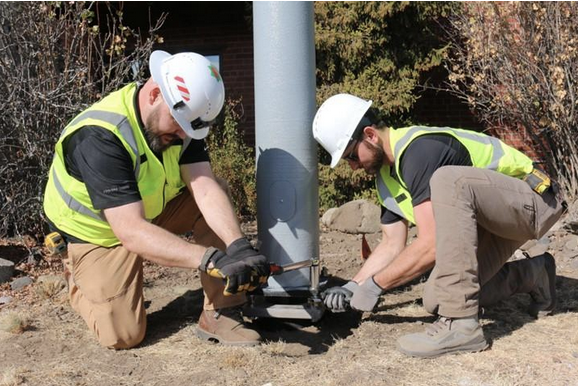
The Ultra-Lightweight Composite Tower made by EasyStreet Systems uses composite pultrusion to convert reinforced fibers and liquid resin into a fiber-reinforced plastic. The poles can be used for 4G, 5G and IoT deployments that need towers up to 50 feet in height. They come in gray, black, brown, and dark green. Custom colors are available.
But what about all of the poles that are already out there, available for small cell equipment?
“The legal issue of pole attachments is being widely discussed in the industry, but the structural integrity of the poles is another issue that needs to be considered,” says Pete Chase, CEO, EasyStreet Systems.
According to EasyStreet Systems, the most common materials used to make existing utility and lighting poles — wood, concrete, and steel — are not necessarily designed or rated for extra equipment such as 5G antennas. Attaching antennas and radio equipment to an existing pole adds wind loading that can lead to a catastrophic failure in the event of a wind storm or an ice storm, says Kent Harrison, CTO, EasyStreet Systems.
He adds, “For standalone structures like an individual small cell or IoT structure, the combined square footage of the objects and equipment mounted on the tower that can catch wind are the driving factor for structural integrity.” Harrison continues, “On poles that have power, cable and fiber lines running from pole to pole, weight itself plays a larger role in the integrity of the pole.”
The need for 5G support comes at a time when existing wood, metal and concrete poles may be showing degradation and destruction from aging, road and ocean salt, weather, wind, animals and other environmental impacts. While plentiful in cities, metal light poles are prone to rusting from the inside out and can fall without warning, says EasyStreet. Spun concrete poles, although resistant to sea air and harsh winds, are vulnerable to corrosion of the reinforcing bars. Additionally, out of the 180 million wood utility poles in service in the U.S., more than 2.5 million have to be replaced annually because of ground line decay and termite attack.
Wood and metal poles show the ravages of time
Composite poles are a viable alternative to legacy pole materials. The composites that make up EasyStreet poles resist corrosion, rot, UV rays, water absorption, insects and woodpeckers. Composite poles do not lose strength as they age, so maintenance is minimal.
Another material difference is the EasyStreet Systems poles are lightweight, strong and have low conductivity properties. For example, the 30-foot EasyStreet 9.8 inch outer diameter tower weighs 210 pounds, compared with 2,000 pounds for a steel pole. This reduces installation costs since heavy equipment and large crews are not needed to install the lightweight poles. Additionally, unlike wood or concrete, the poles are hollow which allows cabling to be run inside of the structure. Plus, their manufacture is much easier on the environment than steel, wooden or concrete poles, according to the company.
Two-man crew installs an EasyStreet composite pole
“A key characteristic of composite poles is the ability to readily adapt mounting locations,” says Harrison. “Not everything runs perfectly in the field. Sometimes small changes have to be made and it’s simple to drill or cut composite material using regular tools.”
Harrison says the most compelling aspect for many customers is the savings in installation costs.
“The biggest savings come from fewer people spending less time per pole, and that translates to a 30-50 percent cost savings,” he says. “When you use light duty equipment, those installation costs are further reduced by as much as 70 percent.”
EasyStreet believes that a 21st century wireless network should not be supported by legacy poles that were initially deployed for a different purpose. EasyStreet Systems composite poles are an economical, strong and sustainable alternative to traditional wood, concrete and steel poles.
For more information, visit https://easystreetsystems.com/.






Reader Interactions